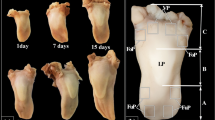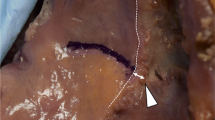Summary
An ultrastructural and a histochemical study of the disintegration of the human fetal palatinal junctional epithelium was carried out.
Special attention was focused both on the epithelium proper as well as on participation of the surrounding mesenchyma.
Epithelial autophagia was noticed in the form of inclusion bodies with cellular remnants as well as general cellular disintegration. The disintegration was correlated to the cellular activity of acid phosphatase and AS-esterase. The differences between human and non-human material were recorded and discussed.
In the surrounding mesenchyma, histiocytes (macrophages) were noticed participating in the epithelial disintegration, while ordinary mesenchymal cells seemed without importance.
The study of activity of alkaline phosphatase reveals that the rapidly growing ossification center of the vomer was touching the superior aspect of the epithelial junctional seams, where the epithelial disintegration starts.
Based upon the findings the following sequential steps of disintegration were discussed: 1) pressure from the outside (the vomer anlage), 2) epithelial autophagia and 3) heterophagia of epithelial remnants (invading histiocytes).
The ultrastructure and histochemistry of the so-called epithelial pearls were described.
The intercellular substance of the palatinal processes was found to consist of hyaluronic acid and of chondroitin-4- and/or-6-sulfate. The mutual ratio of the glycosaminoglucuronoglycans was discussed.
Similar content being viewed by others
References
Andersen, H.: Development, morphology and histochemistry of the early synvial tissue in human foetuses. Acta nat. (Basel) 58, 90–115 (1964).
Andersen, H.: Histochemical investigations on the development of the joint and bone systems of the human foetus during the first half of the prenatal period. Thesis, Copenhagen (1970).
Andersen, H., Bülow, F. A., von, Møllgård, K.: The histochemical and ultrastructural basis of the cellular function of the human foetal adenohypophysis. Progr. Histochem. Cytochem. 1, 153–184 (1970).
Andersen, H., Bülow, F. A. von, Møllgård, K.: The early development of the pars distalis of human foetal pituitary gland. Z. Anat. Entwickl.-Gesch. 135, 117–138 (1971).
Andersen, H., Ehlers, N.: Deamination to prevent the competitive effect of proteins in the metachromatic staining of sections at low pH-values. Histochemie 8, 252–263 (1967).
Andersen, H., Matthiessen, M. E.: The histiocyte in human foetal tissues. Its morphology, cytochemistry, origin, function and fate. Z. Zellforsch. 72, 193–211 (1966).
Andersen, H., Matthiessen, M. E.: Histochemistry of the early development of the human central face and nasal cavity with special reference to the movements and fusion of the palatine processes. Acta anat. (Basel) 68, 473–508 (1967).
Andersen, H., Matthiessen, M. E.: Single-egg human twin foetuses with harelip and cleft palate. Acta anat. (Basel) 70, 219–237 (1968).
Angelici, D., Pourtois, M.: The role of acid phosphatase in the fusion of the secondary palate. J. Embryol. exp. Morph. 20, 15–23 (1968).
Bergeron, J. A., Singer, M.: Metachromasy: An experimental and theoretical re-evaluation. J. biophys. biochem. Cytol. 4, 433–457 (1958).
Bennett, H. S., Watts, R. M.: The cytochemical demonstration and measurement of sulphdryl groups by azoaryl mercaptide coupling, with special reference to mercury orange.. In: General cytochemical methods, ed. by J. F. Danielli. New York: Academic Press Inc. 1958.
Burstone, M. S.: The relationship between fixation and techniques for the histochemical localization of hydrolytic enzymes. J. Histochem. Cytochem. 6, 322–339 (1958).
Burstone, M. S.: Enzyme histochemistry and its application in the study of neoplasms. New York: Academic Press 1962.
Buschmann, R. J., Taylor, A. B.: The effect of 0°C and 2.4-DNP on the uptake of micellar fatty acid on the extraction of absorbed lipid during electron microscopy processing, and on the ultrastructure of everted jejunum. J. Ultrastruct. Res. 35, 98–111 (1971).
Casselman, W. G. B.: Histochemical technique. London: Methuen 1959.
De Angelis, V., Nalbandian, J.: Ultrastructure of mouse and rat palatal processes prior to and during secondary palate formation. Arch. oral Biol. 13, 601–608 (1968).
Farbman, A. I.: Electron microscope study of palate fusion in mouse embryos. Develop. Biol. 18, 93–116 (1968).
Goel, S. C.: Electron microscopic studies on developing cartilage. I. The membrane system related to the synthesis and secretion of extracellular materials. J. Embryol. exp. Morph. 23, 169–184 (1970).
Helminen, H. J., Ericsson, L. E.: Studies on mammary gland involution. II. Ultrastructural evidence for auto- and heterophagocytosis. J. Ultrastruct. Res. 25, 214–227 (1968).
Hughes, L. V., Furstman, L., Bernick, S.: Prenatal development of the rat palate. J. dent. Res. 46, 373–379 (1967).
Kitamura, H.: Epithelial remnants and pearls in the secondary palate in the human abortus: A contribution to the study of the mechanism of cleft palate formation. Cleft Palate J. 3, 240–257 (1966).
Kramer, H., Windrum, G. M.: The metachromatic staining reaction. J. Histochem. Cytochem. 3, 227–237 (1955).
Lillie, R. D.: Histopathologic technic and practical histochemistry, 3. ed. New York: McGraw Hill Book Co. 1965.
Mathews, M. B.: Biophysical aspects of acid mucopolysaccharides relevant to connective tissue structure and function. In: The connective tissue, ed. by B. M. Wagner and D. E. Smith, p. 304–329. Baltimore: Williams & Wilkins Co. 1967.
Mato, M., Aikawa, E., Katahira, M.: Studies on cell-reaction of the nasal epithelium during the fusion to palatine shelves. Anat. Anz. 121, 504–517 (1967).
Meyer, K.: Biochemistry and biology of mucopolysaccharides. Amer. J. Med. 47, 664–672 (1969).
Michaels, J. E., Albright, J. T., Patt, D. I.: Fine structural observations on cell death in the epidermis of the external gills of the larval frog, Rana pipiens. Amer. J. Anat. 132, 301–318 (1971).
Moe, H.: Morphological changes in the infranuclear portion of the enamelproducing cells during their life cycle. J. Anat. (Lond.) 108, 43–62 (1971).
Mowry, R. W.: Revised method producing improved coloration of acidic polysaccharides with Alcian blue 8GX supplied currently. J. Histochem. Cytochem. 8, 323–324 (1960).
Pearse, A. G. E.: Histochemistry, theoretical and applied, 2. ed.. London: J. & A. Churchill Ltd. 1960.
Pearse, A. G. E.: Histochemistry, theoretical and applied, vol. 1, 3. ed. London: J. & A. Churchill Ltd. 1968.
Pourtois, M.: Onset of the acquired potentiality for fusion in the palatal shelves of rats. J. Embryol. exp. Morph. 16, 171–182 (1966).
Scott, J. E., Dorling, J.: Differential staining of acid glycosaminoglycans (mucopolysaccharides) by Alcian blue in salt solutions. Histochemie 5, 221–233 (1965).
Scott, J. E., Dorling, J., Stockwell, R. A.: Reversal of protein blocking of basophilia in salt solutions: Implication in the localization of polyanions using Alcian blue. J. Histochem. Cytochem. 16, 383–386 (1968).
Scott, J. E., Stockwell, R. A.: On the use and abuse of the critical electrolyte concentration approach to the localization of tissue polyanions. J. Histochem. Cytochem. 15, 111–113 (1967).
Smiley, G. R., Dixon, A. D.: Fine structure of midline epithelium in the developing palate of the mouse. Anat. Rec. 161, 293–310 (1968).
Sylvén, B.: On the interaction between metachromatic dyes and various substrates of biological interest. Acta histochem. (Jena) 1, 79–84 (1958).
Wood, P. J., Kraus, B. S.: Prenatal development of the human palate. Some histological observations. Arch. oral Biol. 7, 137–150 (1962).
Author information
Authors and Affiliations
Additional information
This work was supported by grants from Statens almindelige Videnskabsfond, Copenhagen and the Association for the Aid of Crippled Children, New York.
Rights and permissions
About this article
Cite this article
Matthiessen, M., Andersen, H. Disintegration of the junctional epithelium of human fetal hard palate. Z. Anat. Entwickl. Gesch. 137, 153–169 (1972). https://doi.org/10.1007/BF00538788
Received:
Issue Date:
DOI: https://doi.org/10.1007/BF00538788




